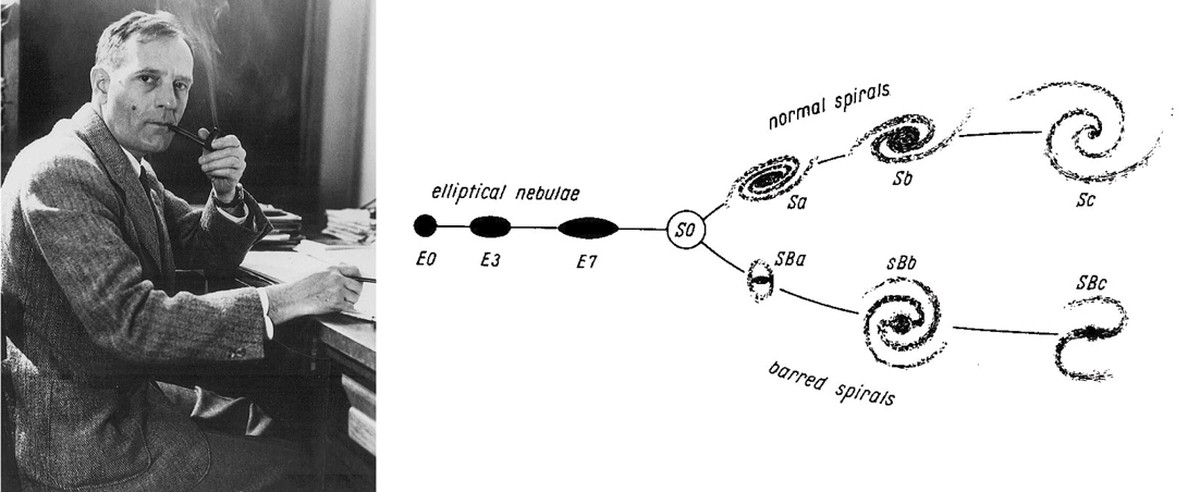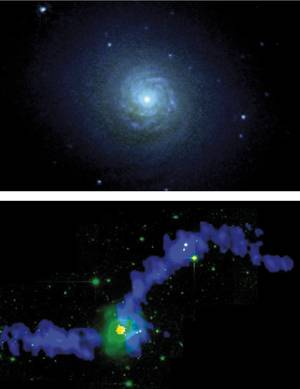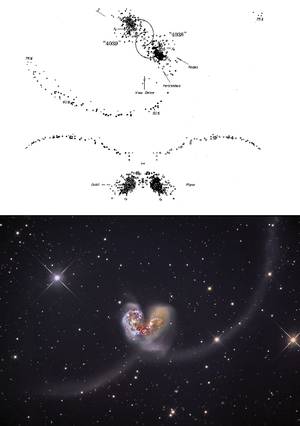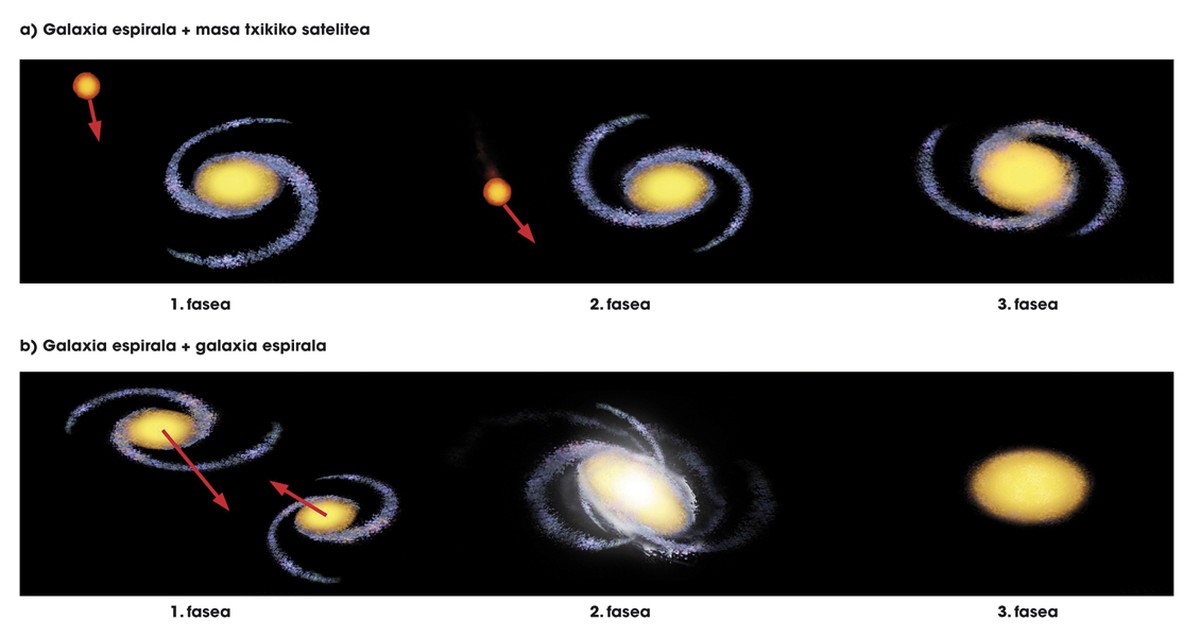When galaxies are found
Giant stars giant stars
At the top of Mount Wilson in California, the world's largest telescope looked at the dark night, with its huge diameter of 100 inches. After the escope of tea, the young Edwin Hubble checked every night that the device was well focused, holding the pipe on his hand, like the Sherlock Holmes pertsonaia. Thanks to the photographs taken by the American astronomer between 1919 and 1926, he solved the mystery at the height of the Baker Street detective: Analyzing the spiral nebulae M31 and M33, he found that these types of stars are gigantic sets of stars away from our galaxy, far from the stars we can see at first sight at night.

The brilliant Edwin Hubble thus resolved the debate that was becoming unending among astronomers. Its symbol is the conference that was held in Washington on April 26, 1920, in which the complex Great Debate theme was analyzed, the spirally shaped nebulae are structures like clouds located in our galaxy or the far farther giant stars, such as the universal islands. And Hubble was the one who put an end to that intense debate, demonstrating that the structures we now consider galaxies are outside our Milky Way. But he also proposed the classification of galaxies according to their morphology. However, thanks to the observations made in recent decades, we know that the “island of universes” is not the best way to express these objects, since in the universe there is hardly anything isolated, nor most galaxies.
Radio waves, a new way of looking at the Universe

Who has not written secret messages with small lemon juice? We wrote with a pen or stick, and although the paper was empty, we knew that the paper kept the message inside. As we approached the fire of a candle, as if it were magic, the message appeared little by little before our eyes. Such a magical manifestation occurred when astronomers looked at the universe with new wavelengths. Our eyes do not receive any light, since we only perceive the colors of the visible spectrum. We also use other wavelengths in everyday life, such as microwave, which help us warm up food, and long waves allow us to listen to the radio. But our eyes cannot grasp these waves, so the first astronomical observations were based on visible wavelengths. In the 1940s, radio waves also began to be used to form a more accurate picture of the universe, which caused some setbacks to astronomers.
One of the surprises is represented in figure 2. In the visual waves, in the image on the left is the spiral galaxy, while the radio waves reveal the tail formed by gas and dust, the influence of the encounter with another galaxy. In addition, when using new wavelengths, many galaxies were found outside the classification proposed by astronomer Edwin Hubble and are collected in the catalogue called Arp. Special systems such as Antennae (Figure 3) showed the existence of galaxies with really curious morphologies in the universe, most of them unfinished encounters.

It would be very nice to witness one of those cosmic dances. Unfortunately, our short time scales make us unable to follow the evolution of galaxies. In the Universe, the longer the distances are, the longer the time scales needed to detect changes, and galaxies are so large that their dances last hundreds of millions of years. But thanks, astronomers have the way to face this problem: simulations. The first simulations of galaxy encounters were performed in 1972 by the Toomre brothers (see figure 3). Since then, more precise computer models have been developed that allow us to know that intergalactic encounters are a unique spectacle: sometimes they form a slow dance, like the rafts; other times they are violent unions that completely transform the structure of galaxies.
Birth of stars and galaxies
Surprisingly, the clash between stars almost never occurs when galaxies are found. How can two giant stars, formed by billions of stars, come together without a pair of stars as a result of this process? The reason is quite simple and the direct influence of the spatial scales. The distance between the stars is millions of times larger than the size of the stars, so the probability of finding them between them is very small. For example, the Sun has a diameter of approximately one million kilometers and the star closest to the Sun, Proxima Centauri, is at 40 billion kilometers of similar diameter. To illustrate the difference between size and distance, we can use the football field: if these two stars were placed at the ends of the field, the Sun should have the size of a dust mute to keep the proportion!
Therefore, most of the galaxies are pure or, better said, full of gases and very low density dust. Therefore, what really collides in galactic junctions is gas, creating new stars. The details are still not known exactly, but it seems that the encounter gives rise to a change in the dynamics of galaxies, directing the gas to the center; as the compression it supposes, the increase of the density of interstellar gas, the fragmentation and the birth of new stars in the process.
So far we have not mentioned which parameters condition the result of the meeting. It is clear that the morphology of the original galaxies will have to do with the result: it is not the same as two spiral galaxies meet or two elliptic galaxies come together. The characteristics of galaxy orbits are also important: initial velocity, direction, rotation movement of each galaxy... However, there is a characteristic that divides all the joints into two large groups: the mass ratio between the two galaxies. If one galaxy is much smaller than the other (smaller merger), the large galaxy seamlessly captures the other; in this cannibalist process one can detect a tail of stars and gases that the small galaxy leaves behind. The main galaxy, on the other hand, slightly increases the internal spheroid or bulb (moving to the left in the Hubble diagram), but without altering it too much. This type of modest unions are much more common than expected, and today we think that most galaxies have suffered at least one of them throughout their lives.

At the other end of the mass ratio, we find in English violent and spectacular encounters called major merger. When the two galaxies have a similar mass, very different shapes can appear during the crash. If the original galaxies were spirals, the spiral structure is completely broken, and in the center appears a cluttered ball that was formed back to a born star, with the fireworks of the union around it. However, after a few hundred million years, the material of these outer tails will be dispersed and, as the violent collision has exhausted all the gas, no new stars will emerge. From that moment on we will have in hand a red elliptical galaxy of old stars.
The future of the Milky Way
Our galaxy has also had and will have the visit of the neighbors. Analyzing with the telescope the area called halo, we have been able to verify that we are surrounded by remains of stars that has conquered our Milky Way. Consequently, we can affirm that the current structure of the Milky Way is a consequence of these simple encounters. But what's more, we've caught our galaxy full while eating another galaxy. The Dwarf Galaxy of Sagittarius is a satellite of the Milky Way that rotates around it, but little by little our Milky Way also attracts the regan, decreasing the distance between both. As in the above examples, the small mass of the dwarf galaxy of Sagittarius is gradually destroying the union as it advances, leaving behind a long tail of hydrogen and dust.
But what is the future of the Milky Way itself? Will there always be a spiral galaxy? To clarify this, we should look at our most massive neighbors. The galaxy of Andromeda, by the way, is quite close and, as the velocity measures indicate, it approaches: the clash between both galaxies is inevitable. The union will take place within billions of years and then we will be inhabitants of a new galaxy. This newly created galaxy will be giant and outside will be noticed a reddish color; then we will be inhabitants of a large elliptical galaxy. The concrete characteristics of cosmic dance that will lead us to this result we still cannot know, but it is clear that it deserves to be witness of this unique spectacle.
Bibliography Bibliography Bibliography
Cox, T. J.; Loeb, A. (2008). “The collision between the Milky Way and Andromeda”. Monthly Notices of the Royal Astronomical Society, 386.
Kennicutt, R. C.; Schweizer, F.; Barnes, J.E. (1998). “Galaxies: Interactions and induced star formation”. SAAS-Fee Advanced Course, 26.
Smith, B.; Higdon, J.; Higdon, S.; Bastian, N. (2010). “Galaxy Wars: Star Formation and Stellar Populations in Interacting Galaxies”. ASP Conference Series, 423.
Toomre, A.; Toomre, J. (1972). “Galactic Bridges and Tails” Astrophysical Journal, 178.






